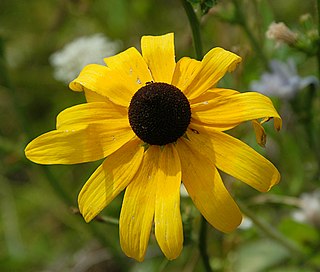
Pursat is a province (khaet) of Cambodia. It is in the western part of the country and borders clockwise from the north: Battambang Province, the Tonlé Sap, Kampong Chhnang Province, Kampong Speu Province, Koh Kong Province, and Thailand. It lies between the Tonle Sap and the northern end of the Cardamom Mountains. The Pursat River bisects the province, running from the Cardamoms in the west to the Tonle Sap in the east.

Rudbeckia hirta, commonly called black-eyed Susan, is a North American flowering plant in the family Asteraceae, native to Eastern and Central North America and naturalized in the Western part of the continent as well as in China. It has now been found in all 10 Canadian Provinces and all 48 of the states in the contiguous United States.

Agarwood, aloeswood, eaglewood or gharuwood is a fragrant dark resinous wood used in incense, perfume, and small carvings. It is formed in the heartwood of aquilaria trees when they become infected with a type of mold. Prior to infection, the heartwood is odourless, relatively light and pale coloured; however, as the infection progresses, the tree produces a dark aromatic resin, called aloes or agar as well as gaharu, jinko, oud, or oodhaguru, in response to the attack, which results in a very dense, dark, resin-embedded heartwood. The resin-embedded wood is valued in Indian-North Eastern culture for its distinctive fragrance, and thus is used for incense and perfumes. Its name is believed to have first and foremost Sanskrit origin, formed from ‘Aguru’. The aromatic qualities of agarwood are influenced by the species, geographic location, its branch, trunk and root origin, length of time since infection, and methods of harvesting and processing.

Aquilaria is a genus of fifteen species of trees, called lign aloes or lign-aloes trees, in the family Thymelaeaceae, native to southeast Asia. They occur particularly in the rainforests of Indonesia, Thailand, Cambodia, Laos, Vietnam, Malaysia, Northeast India, Bangladesh, the Philippines, Borneo and New Guinea. The trees grow to 6–20 m tall. The leaves are alternate, 5–11 cm long and 2–4 cm broad, with a short acuminate apex and an entire margin. The flowers are yellowish-green, produced in an umbel; the fruit is a woody capsule 2.5–3 cm long.

Miconia crenata,, commonly called soapbush, clidemia or Koster's curse, is a perennial shrub. It is an invasive plant species in many tropical regions of the world, creating serious damage.

Archon apollinus, the false Apollo, is a species of butterfly belonging to the Parnassinae subfamily.
Calamagrostis hirta is a species of grass in the family Poaceae.

The lesser red musk shrew is a species of mammal in the family Soricidae. It is found in Angola, Botswana, Democratic Republic of the Congo, Malawi, Mozambique, Namibia, South Africa, Eswatini, Tanzania, Zambia, and Zimbabwe. Its natural habitats are dry savanna, moist savanna, subtropical or tropical dry lowland grassland, and hot deserts.
Genophantis leahi was a species of moth in the family Pyralidae described by Otto Herman Swezey in 1910. It was endemic to the Hawaiian islands of Maui, Oahu, Molokai and Hawaii.
Aquilaria banaensae is a species of plant in the Thymelaeaceae family. It is endemic to Vietnam.
Aquilaria beccariana is a species of plant in the Thymelaeaceae family. It is found in Indonesia and Malaysia. It is threatened by habitat loss.

Aquilaria crassna is a species of plant in the Thymelaeaceae family. It is found in throughout Southeast Asia and in New Guinea.
Aquilaria cumingiana is a species of plant in the Thymelaeaceae family. It is found in Indonesia and the Philippines.

Aquilaria malaccensis is a species of plant in the Thymelaeaceae family. It is found in Bangladesh, Bhutan, India, Indonesia, Laos, Malaysia, Myanmar, the Philippines, Singapore, and Thailand. It is threatened by habitat loss.
Aquilaria microcarpa is a species of plant in the Thymelaeaceae family. It is found in Indonesia and Singapore.
Aquilaria rostrata is a species of tree in the family Thymelaeaceae. It is endemic to Peninsular Malaysia. It is sometimes used for agarwood, but unsustainable harvesting is believed to be threatening agarwood-producing species and therefore is discouraged by environmental groups.

Aquilaria sinensis is a species of plant in the family Thymelaeaceae. It is endemic to China. It is threatened by habitat loss. This medicinal plant is a source of fragrant wood, formed under a pathological condition, called Chen Xiang in Standard Mandarin, or chàhm hēung in Cantonese, or agarwood.
Rondeletia hirta is a species of plant in the family Rubiaceae. It is endemic to Jamaica. It is threatened by habitat loss.

Gyrinops is a genus of nine species of trees, called lign aloes or lign-aloes trees, in the Thymelaeaceae family. They are native to Southeast Asia and the Indian Subcontinent.
Diplotaxis hirta is a species of flowering plants of the family Brassicaceae. The species is endemic to Cape Verde. It is listed as an endangered plant by the IUCN.










